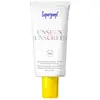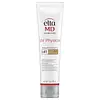What's inside
What's inside
 Key Ingredients
Key Ingredients

 Benefits
Benefits

 Concerns
Concerns

 Ingredients Side-by-side
Ingredients Side-by-side

Butyl Methoxydibenzoylmethane 3%
UV AbsorberHomosalate 8%
Skin ConditioningEthylhexyl Salicylate 5%
UV AbsorberOctocrylene 4%
UV AbsorberIsododecane
EmollientDimethicone Crosspolymer
Emulsion StabilisingDimethicone/Bis-Isobutyl PPG-20 Crosspolymer
EmollientPolymethylsilsesquioxane
Isohexadecane
EmollientDicaprylyl Carbonate
EmollientMeadowfoam Estolide
Skin ConditioningCaprylic/Capric Triglyceride
MaskingPolyester-7
Skin ConditioningNeopentyl Glycol Diheptanoate
EmollientLithothamnion Calcareum Extract
Skin ConditioningCaprylyl Glycol
EmollientButyrospermum Parkii Butter
Skin ConditioningJojoba Esters
EmollientMannitol
HumectantBoswellia Serrata Resin Extract
SmoothingLecithin
EmollientMicrocrystalline Cellulose
AbsorbentDiatomaceous Earth
AbrasiveZinc Sulfate
AntimicrobialSilica
AbrasiveTocopherol
AntioxidantButyl Methoxydibenzoylmethane 3%, Homosalate 8%, Ethylhexyl Salicylate 5%, Octocrylene 4%, Isododecane, Dimethicone Crosspolymer, Dimethicone/Bis-Isobutyl PPG-20 Crosspolymer, Polymethylsilsesquioxane, Isohexadecane, Dicaprylyl Carbonate, Meadowfoam Estolide, Caprylic/Capric Triglyceride, Polyester-7, Neopentyl Glycol Diheptanoate, Lithothamnion Calcareum Extract, Caprylyl Glycol, Butyrospermum Parkii Butter, Jojoba Esters, Mannitol, Boswellia Serrata Resin Extract, Lecithin, Microcrystalline Cellulose, Diatomaceous Earth, Zinc Sulfate, Silica, Tocopherol
Zinc Oxide 9%
Cosmetic ColorantTitanium Dioxide 7%
Cosmetic ColorantWater
Skin ConditioningIsopropyl Palmitate
EmollientEthylhexyl Stearate
EmollientOctyldodecyl Neopentanoate
EmollientAlumina
AbrasivePolyacrylate-13
Phenoxyethanol
PreservativeHydrogen Dimethicone
Polyisobutene
Hydrogenated Polyisobutene
EmollientTriethoxycaprylylsilane
Oleth-3 Phosphate
Tocopheryl Acetate
AntioxidantBisabolol
MaskingTocopherol
AntioxidantCarnosine
Skin ConditioningEthylhexylglycerin
Skin ConditioningSorbitan Isostearate
EmulsifyingPolysorbate 20
EmulsifyingZingiber Officinale Root Extract
MaskingIron Oxides
Zinc Oxide 9%, Titanium Dioxide 7%, Water, Isopropyl Palmitate, Ethylhexyl Stearate, Octyldodecyl Neopentanoate, Alumina, Polyacrylate-13, Phenoxyethanol, Hydrogen Dimethicone, Polyisobutene, Hydrogenated Polyisobutene, Triethoxycaprylylsilane, Oleth-3 Phosphate, Tocopheryl Acetate, Bisabolol, Tocopherol, Carnosine, Ethylhexylglycerin, Sorbitan Isostearate, Polysorbate 20, Zingiber Officinale Root Extract, Iron Oxides
 Reviews
Reviews

Ingredients Explained
These ingredients are found in both products.
Ingredients higher up in an ingredient list are typically present in a larger amount.
Tocopherol (also known as Vitamin E) is a common antioxidant used to help protect the skin from free-radicals and strengthen the skin barrier. It's also fat soluble - this means our skin is great at absorbing it.
Vitamin E also helps keep your natural skin lipids healthy. Your lipid skin barrier naturally consists of lipids, ceramides, and fatty acids. Vitamin E offers extra protection for your skin’s lipid barrier, keeping your skin healthy and nourished.
Another benefit is a bit of UV protection. Vitamin E helps reduce the damage caused by UVB rays. (It should not replace your sunscreen). Combining it with Vitamin C can decrease sunburned cells and hyperpigmentation after UV exposure.
You might have noticed Vitamin E + C often paired together. This is because it is great at stabilizing Vitamin C. Using the two together helps increase the effectiveness of both ingredients.
There are often claims that Vitamin E can reduce/prevent scarring, but these claims haven't been confirmed by scientific research.
Learn more about Tocopherol